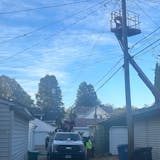Walking through any Minnesota woods, I compulsively search the ground looking for the telltale signs: small-toothed leaves at the edge of a path, a glimpse of red at just the right angle. Score!
I eagerly move in for a few gentle plucks and hold up some wild strawberries. Their flavors burst out, concentrated and tangy, as if to overcompensate for their diminutive size.
If strawberries are past their season, my eyes move upward scanning for one- to two-foot shrubs polka-dotted with blueberries. They drop beautifully into my bandanna, hastily knotted into an extra pocket for occasions such as these.
July is often bonanza time for finding wild berries in Minnesota. Strawberries usually show up by mid- to late June, followed by blueberries in early to mid-July, and a parade of lesser-known bounties. Good news if you're late to the foraging party: This year's winter-that-wouldn't-quit delayed the harvest.
"They are at least two weeks behind," says Theresa Marrone, author of "Wild Berries & Fruits Field Guide of Minnesota, Wisconsin and Michigan" (Adventure Publications). That includes berries in the Twin Cities and central Minnesota, along with the North Shore, where blueberries and thimbleberries were blooming in late June.
That could bring a delicious bounty by the end of the month — especially along paths and the edge of forests where you can still find thickets of blackcaps (black raspberries) and wild raspberries that, once plucked, catch the sun like rubies.
The trick, of course, is not only good timing, but knowing where to find the fruit. Passionate berry-pickers are as willing to divulge their favorite patches as anglers are their secret fishing spots, says Steve Robertsen, interpreter at Superior National Forest's Tofte office. Experts like Robertsen, thankfully, are more forthcoming. Here are their tips:
FIND THE RIGHT HABITAT
Blueberries favor meadows in piney areas with more acidic soil — most bountiful in northern Minnesota. Strawberries grow low to the ground throughout woodsy areas that span the state, especially along trails offering extra sunlight. Blackcaps and red raspberries can also be found throughout most of the state along the edge of forests.

